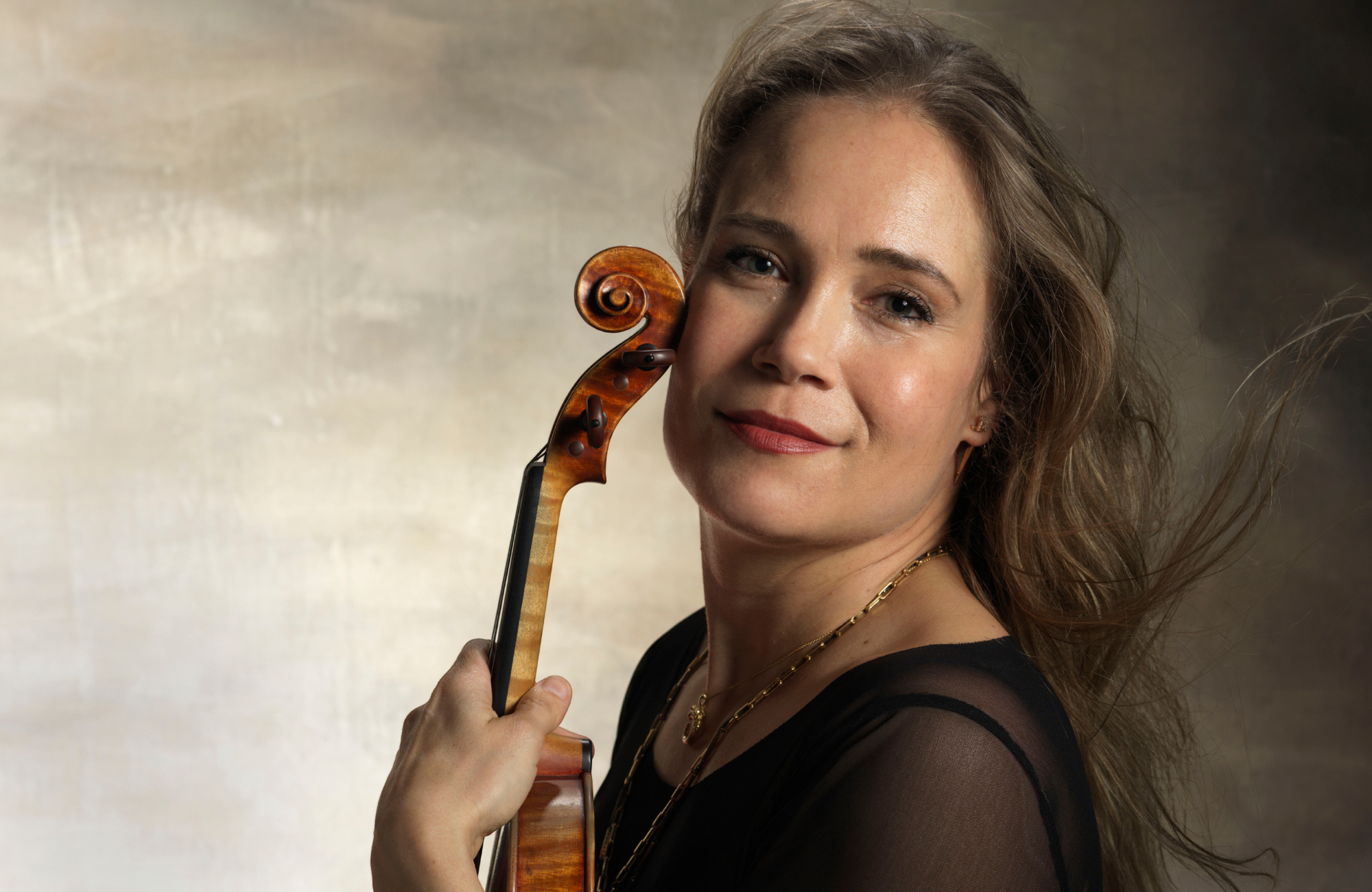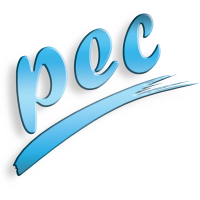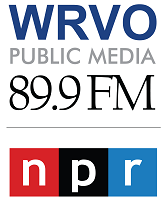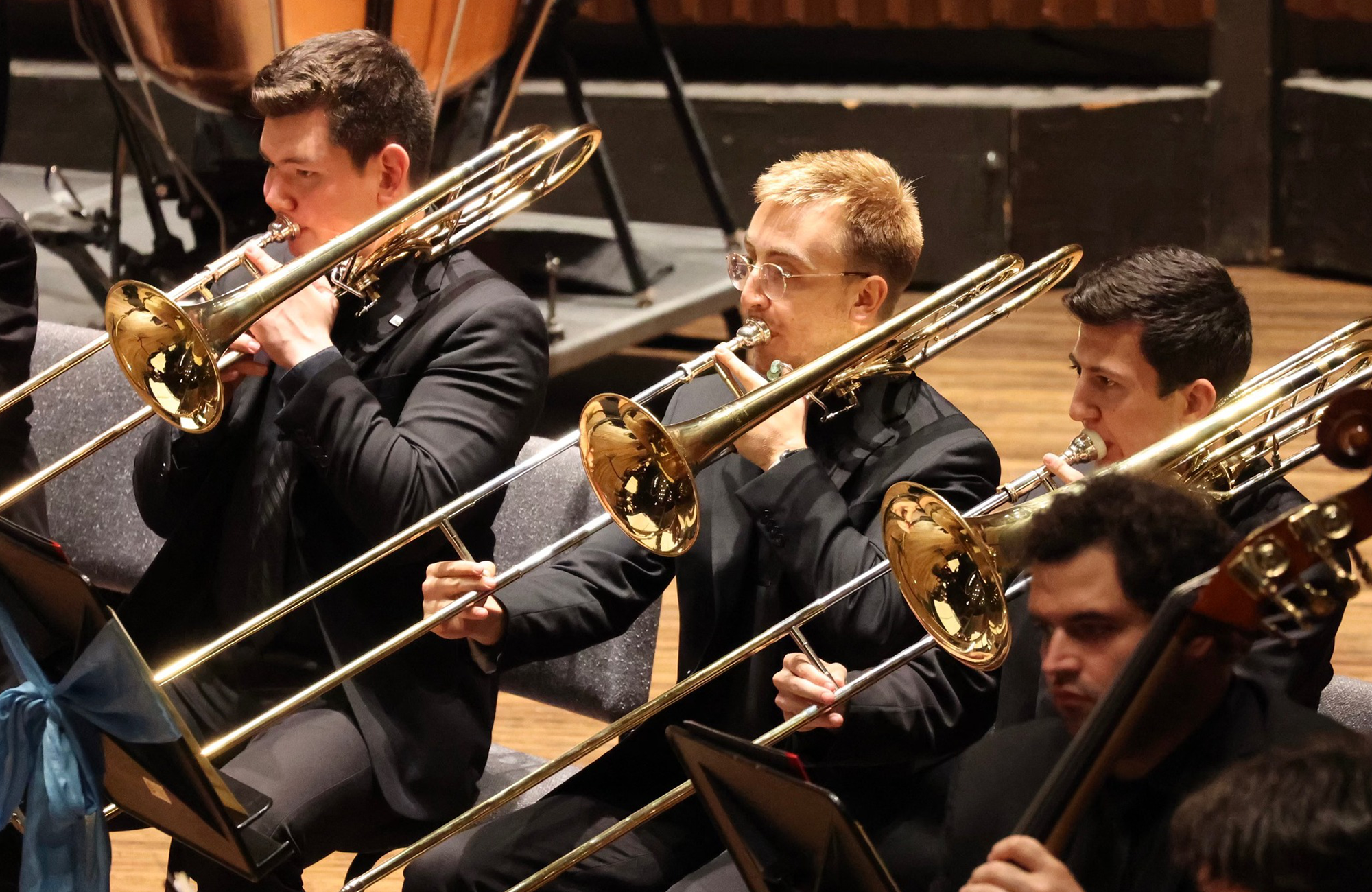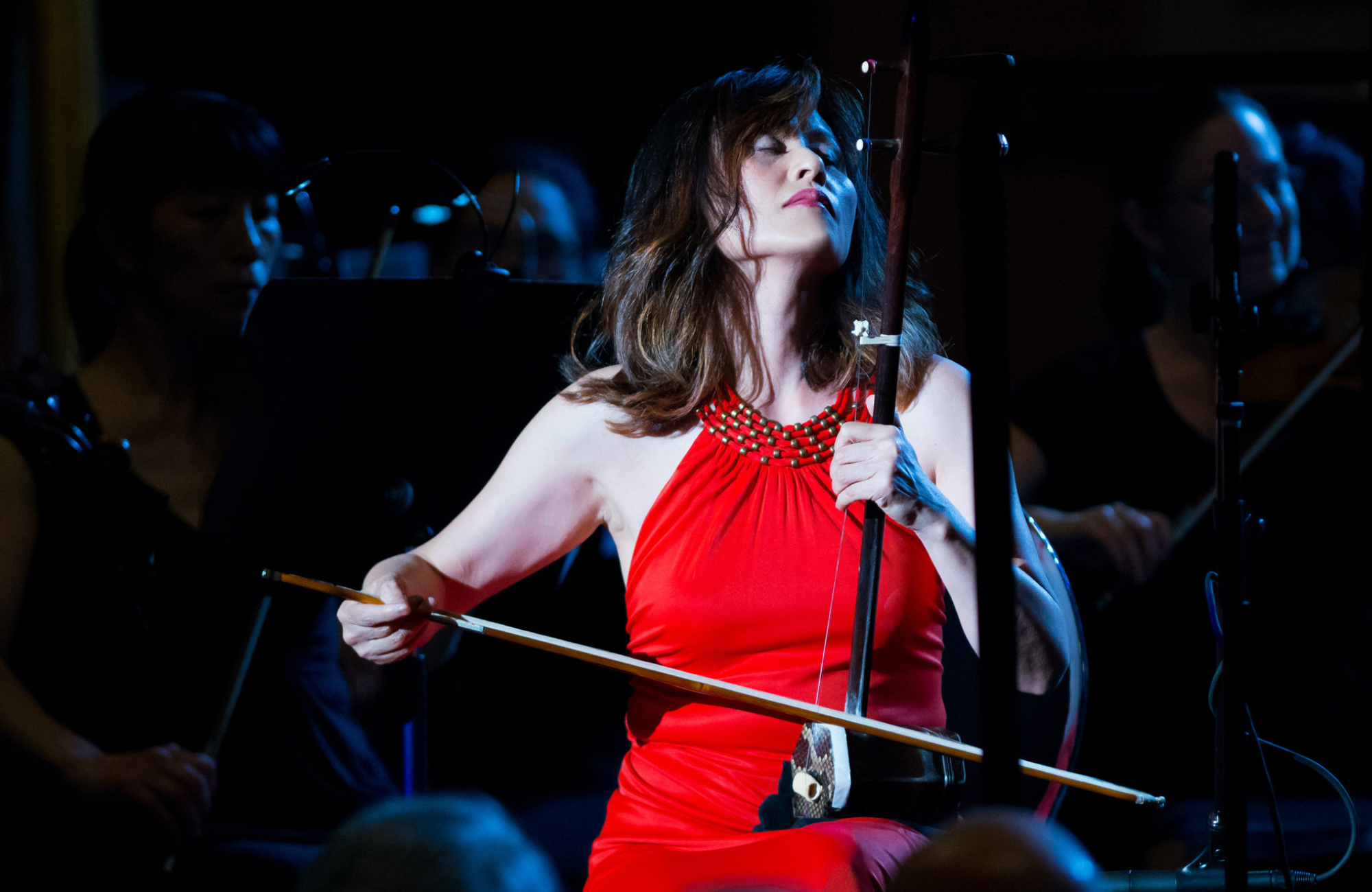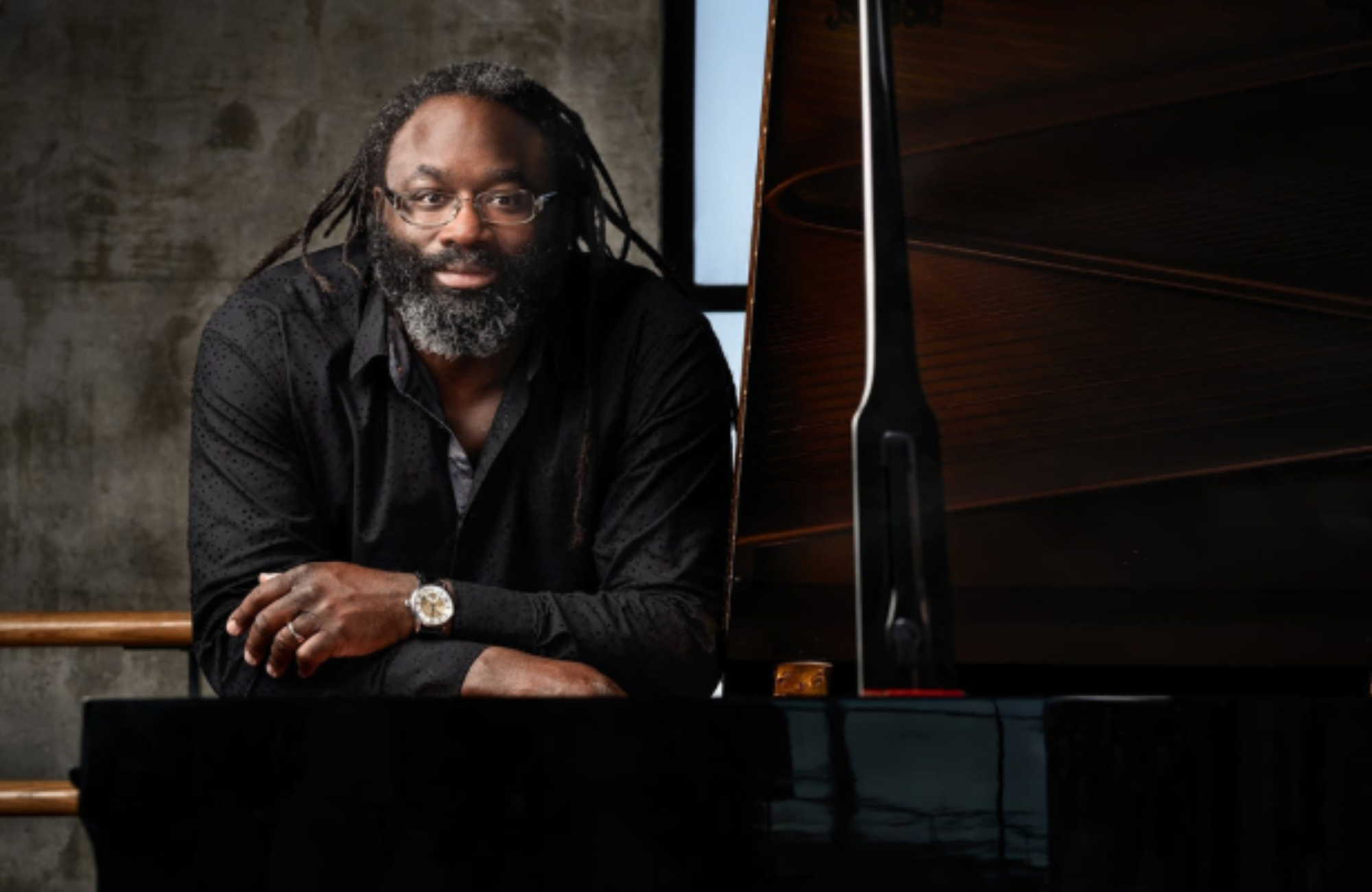Famed violinist Leila Josefowicz performs the Violin Concerto by Pulitzer Prize-winning composer John Adams. We begin the program with Copland’s musical portrayal of a dance hall with El Salón México and finish with Dvorak’s New World Symphony.
PROGRAM
COPLAND: El Salon Mexico ![]()
ADAMS: Violin Concerto ![]()
DVORAK: Symphony No. 9 ![]()
Thanks to our generous sponsors!
LARRY’S LISTENING RECOMMENDATIONS
PROGRAM NOTES
Louis Moreau Gottschalk (1829–1869)—the first US composer with an international reputation—took his inspiration largely from the vernacular music of the Americas. But by the end of the 19th century, most American composers, seeking status, had turned to Europe and found their music hopelessly trapped in European conventions. To counter this trend, in 1891 Jeannette Thurber, president of the National Conservatory of Music in New York, asked Antonín Dvořák (1841–1904) to serve as the school’s artistic director. Granted, Dvořák was a European; but he wrote music based on his own nation’s folk music, and ...
Louis Moreau Gottschalk (1829–1869)—the first US composer with an international reputation—took his inspiration largely from the vernacular music of the Americas. But by the end of the 19th century, most American composers, seeking status, had turned to Europe and found their music hopelessly trapped in European conventions. To counter this trend, in 1891 Jeannette Thurber, president of the National Conservatory of Music in New York, asked Antonín Dvořák (1841–1904) to serve as the school’s artistic director. Granted, Dvořák was a European; but he wrote music based on his own nation’s folk music, and she hoped that he would encourage US composers to follow suit. Her expectations were fulfilled. During his years in the United States (1892–1895), he had a profound effect, pushing the country’s music in new directions.
Especially important was the influence of his 1893 Symphony No. 9 (“From the New World”), which was written during his stay here and came to represent a new approach to composition grounded in the African American and Native American traditions Dvořák admired. True, it’s not clear just how much Americana really is in the score. Thus, for instance, the English horn sings out the tune familiar as “Goin’ Home” in the second movement. But “Goin’ Home” is not a pre-existing folk spiritual; it was composed nearly three decades later by William Arms Fisher, a White student of Dvořák’s—and was specifically based on Dvořák’s tune. Still, even if there are no direct quotations from American folk traditions, and even if the symphony seems to be yearning for the Old World as much as it is celebrating the New, there’s no doubt that Dvořák was inspired by the “fundamental characteristics” of music he heard in the United States. That inspiration has served as a possible model for composers for over a century.
It didn’t hurt that the “New World” Symphony was a hit from its premiere; and if you’re coming to the work for the first time, you—like those early listeners—will probably be swept up in its energy and its melodic beauty, as well as by the way themes from one movement reoccur elsewhere in the symphony. The immediacy of its impact is one reason the work has long served as an ideal introduction to symphonic music (it was, in fact, one of the pieces that first drew conductor Larry Loh to classical music as a child). But if you know it already, you’ll probably find new wonders each time you listen to it—which is why it has stayed at the heart of the repertoire.
In any case, as I’ve pointed out, Dvořák’s outspoken support for local music caught on. His influence is not easy to trace precisely, and it was not universal; but it’s fair to say that in the wake of his visit, US concert music increasingly drew on American traditions.
Sometimes, the term “American” was limited to the United States; sometimes, it was broader in scope. Gottschalk’s inspiration came from patriotic songs and folk music from both North and South Americas—and while Aaron Copland (1900 –1990) did not write exclusively folk-inspired music, when he did, he too drew from beyond the United States. For instance, El Salon Mexico (1932–36), stimulated by visits to a popular dance hall in Mexico City to which he had been introduced by his close friend Mexican composer Carlos Chavez, is based on popular Mexican dance tunes.
Yet this, his first major orchestral work based on folk materials, is more than a compilation of pre-existing melodies. Copland was, at the time, struggling to balance his modernist aesthetic with his developing left-wing politics, and the result was a work that transformed the music he borrowed in ways that reflected his more radical musical techniques. That is, as he put it, his goal was “not merely to quote literally, but to heighten without in any way falsifying the natural simplicity of Mexican tunes.” The borrowed material is often fractured, reworked, and reharmonized, and then used as the building blocks of a more complex structure. The result is a kaleidoscopic distillation of the music’s essence, an attempt to convey the “spirit” of the music (and its people) without being trapped in its letter.
Copland did not engage in this project naively. Realizing that he was just a musical “tourist,” was also concerned that he might be engaging in cultural appropriation. Fortunately, the enthusiasm of the Orquesta Sinfónica de México at the premiere (under Chavez) did much to quell his anxieties, and the work has remained one of Copland’s most successful.
At first glance, the 1993 Violin Concerto by John Adams (b. February 15, 1947), which forms the center of our concert, doesn’t seem to have much in common with its neighbors. Unlike most of Adam’s other work (most notably the operas Nixon in China and Dr. Atomic), it doesn’t have any of the political motivation that drives Copland. Indeed, it is one of his few completely non-programmatic works. Nor is it fueled by the folk music that inspired both Copland and Dvo?ák. But it does, in fact, have one key aspect in common: a reliance on melody.
Adams’s earlier work was grounded primarily in harmony and especially rhythm—but in the 1990’s, while working on his opera The Death of Klinghoffer, he began, he says, “to think more about melody.” And when he came to writing the Concerto in 1993, “as if to compensate for years of neglecting the ‘singing line,’ the Violin Concerto emerged as an almost implacably melodic piece —a example of ‘hypermelody.’ The violin spins one long phrase after another without stop for nearly the full 35 minutes of the piece.”
The work is in three movements. If you know Berg’s Wozzeck, the first movement might at first reveal a certain kinship with the Third Act’s eerie drowning scene, a moment of exquisite vagueness and instability. But it soon begins to coalesce, and reveals itself as what tonight’s soloist, Leila Josefowicz, calls “sort of a flying improvisation, one that has a joyful, very jazzy dance kind of feeling.”
It’s followed by a chaconne—a work in which a repeated bass pattern serves as a constant underpinning, as lines develop above it. This movement is titled “Body Through Which the Dream Flows”; Adams took the phrase from a poem by Robert Haas, “words that suggested,” the composer noted, “the duality of flesh and spirit that permeates the movement.” As Leila says, “it is very beautiful, very meditative, and also a little bit haunting.” Its haunting quality comes partly from the contribution of the synthesizers. There’s a bit of a paradox here. The music was always haunting, even when new; but forty years on, these sounds have increasingly taken on a surprisingly old-fashioned quality—what Leila calls “a sweet nostalgic space-age effect.”
As for the finale: it’s titled “Toccare,” the Italian word for “touch,” which is the origin of the musical term “toccata,” usually a fast, virtuoso piece. This movement certainly meets the expectations of the word: “It’s a real party piece. So in many ways, this is a giant showpiece in many uses of the word.”
Given its classical overlay—Adams’ reliance on the standard fast-slow-fast structure— and given the centrality of melody, you might expect a throwback to the 19th-century concerto, perhaps a super-Brahms. Not quite. For all its ties to tradition, it has, says Leila, “this magical quality that no other concerto has.” So how should we listen to it in order to best absorb this magical quality? Although it’s all written out—strictly and intricately—it has an improvisatory feeling. And Leila suggests that we not treat it as a typical “classical” concerto but instead imagine that we’re “going to a jazz club.”
Leila has, for decades, centered on performing new music. I ask her why. One reason, of course, is the joy of actually working with the composers she’s playing. “That has been such an incredible thing for me to experience—you can have conversations with a creator about his or her own music, can share ideas.” In fact, she met Adams at her second performance of this piece, after which she had a chance to travel and play it often with him—and to work with him on his later symphony for violin and orchestra, Scheherazade 2.0. “This has been absolutely life-altering.”
But it goes beyond the personal reward: “We must continue this art form; it has to continue to live. So many listeners love comparative listening in the sense that they have favorite pieces, favorite recordings, favorite moments, which is totally understandable and natural. But there’s also a different way of listening to music—as if you’re going, say, on a journey to an area of the world you’ve never visited before. This very important aspect of exploration is necessary to continue this art form. We need these performances, and we need the support and the appreciation, because as wonderful as it is to play music that’s hundreds of years old, what about the great creative minds that are spilling their guts in order to get these notes out, living and breathing composers who are writing music this afternoon? They’re out there, and it’s really important to honor them.” I think that tonight’s performance will convince you of why this commitment matters.
Peter J. Rabinowitz
Have any comments or questions? Please write to me at prabinowitz@SyracuseOrchestra.org
FEATURED ARTISTS
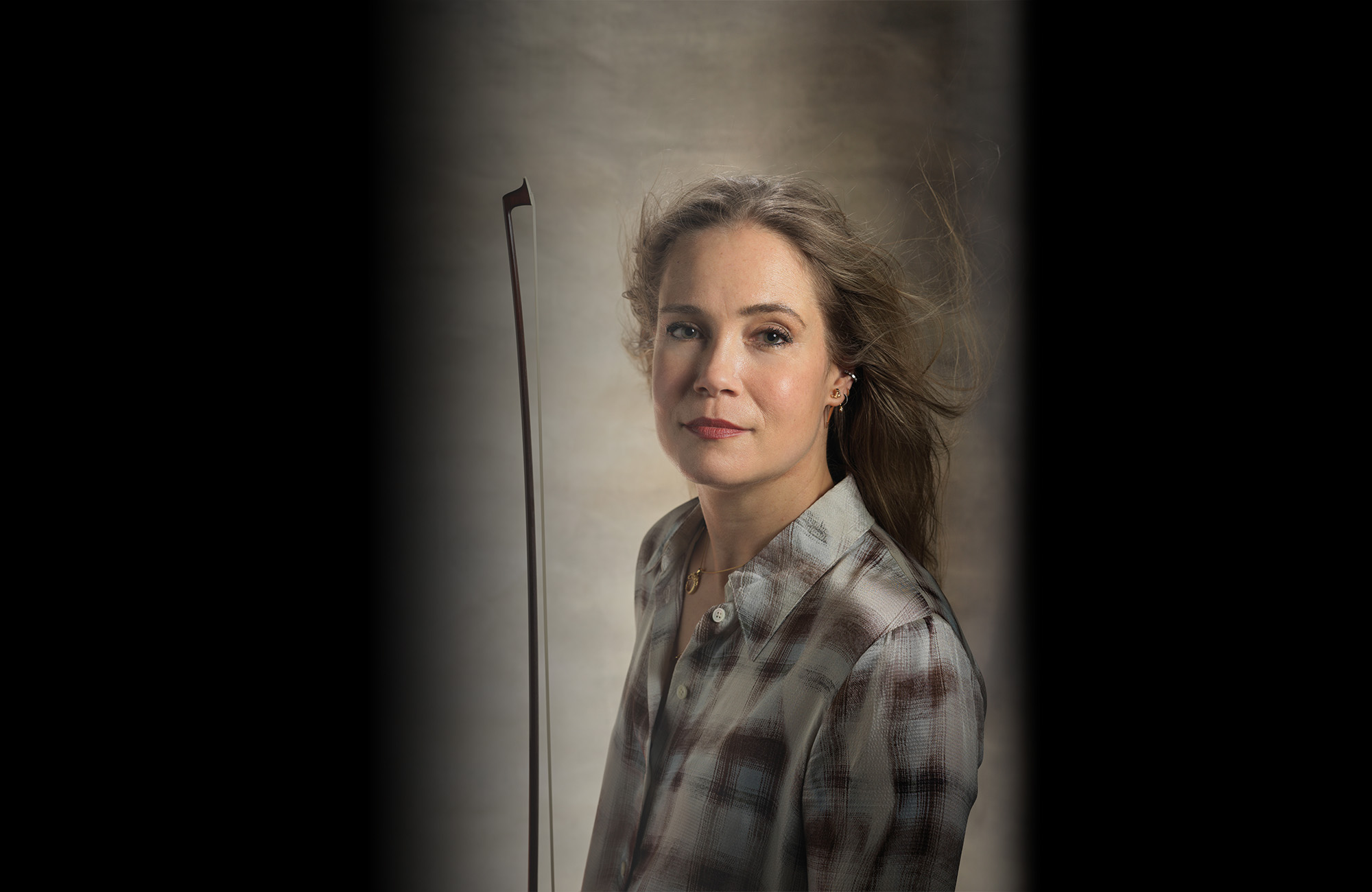
Leila Josefowicz’s passionate advocacy of contemporary music for the violin is reflected in her diverse programmes and enthusiasm for performing new works. A favourite of living composers, Josefowicz has premiered many concertos, including those by Colin Matthews, Luca Francesconi, John Adams and Esa-Pekka Salonen, all written specially for ...
Leila Josefowicz’s passionate advocacy of contemporary music for the violin is reflected in her diverse programmes and enthusiasm for performing new works. A favourite of living composers, Josefowicz has premiered many concertos, including those by Colin Matthews, Luca Francesconi, John Adams and Esa-Pekka Salonen, all written specially for her.
Artist-in-Residence of Iceland Symphony Orchestra for the 2023/24 season, Josefowicz will perform Helen Grime’s Violin Concerto with Daniel Bjarnason and Bartók’s Violin Concerto No.2 with Eva Ollikainen, as well as present a solo recital at Harpa Hall. Elsewhere, Josefowicz’s season includes engagements with Die Deutsche Kammerphilharmonie Bremen, Musikkollegium Winterthur, London Philharmonic Orchestra, and Lahti, Milwaukee, Taipei and Antwerp symphony orchestras. Josefowicz also presents the world premiere of Jüri Reinvere’s Concerto for Violin and Harp alongside Trina Struble and The Cleveland Orchestra, and tours Germany and Austria with Junge Deutsche Philharmonie with concerts Berlin, Vienna and Dresden.
Highlights of recent seasons include appearances with Berliner Philharmoniker; Tonhalle-Orchester Zürich; Royal Concertgebouworkest; Konzerthausorchester Berlin; Dresden Philharmonie, Oslo, Helsinki and Los Angeles Philharmonic orchestras; NDR Elbphilharmonie; the Boston, Chicago, San Francisco, The Cleveland, and The Philadelphia orchestras, where she worked with conductors at the highest level, including Matthias Pintscher, John Storgårds, Esa-Pekka Salonen, Louis Langrée, Hannu Lintu and John Adams.
Josefowicz enjoyed a close working relationship with the late Oliver Knussen, performing various concerti, including his violin concerto, together over 30 times. Other premieres have included Matthias Pintscher’s Assonanza with Cincinnati Symphony Orchestra, John Adams’ Scheherazade.2 with New York Philharmonic, Luca Francesconi’s Duende – The Dark Notes with Swedish Radio Symphony Orchestra and Steven Mackey’s Beautiful Passing with BBC Philharmonic.
Together with John Novacek, with whom she has enjoyed a close collaboration since 1985, Josefowicz has performed recitals at world-renowned venues such as New York’s Zankel Hall and Park Avenue Armory, Washington DC’s Kennedy Center and Library of Congress and London’s Wigmore Hall, as well as in Reykjavik, Trento, Bilbao and Chicago. This season their collaboration continues with recitals in California, appearing at Festival Mozaic, UC Santa Barbara, San Francisco Performances and Los Angeles Philharmonic’s Colburn Celebrity Recital series.
Josefowicz has released several recordings, notably for Deutsche Grammophon, Philips/Universal and Warner Classics and was featured on Touch Press’s acclaimed iPad app, The Orchestra. Her latest recording, released in 2019, features Bernd Alois Zimmermann’s Violin Concerto with Finnish Radio Symphony Orchestra conducted by Hannu Lintu. She has previously received nominations for Grammy Awards for her recordings of Scheherazade.2 with St Louis Symphony conducted by David Robertson, and Esa-Pekka Salonen’s Violin Concerto with Finnish Radio Symphony Orchestra conducted by the composer.
In recognition of her outstanding achievement and excellence in music, she won the 2018 Avery Fisher Prize and was awarded a prestigious MacArthur Fellowship in 2008, joining prominent scientists, writers and musicians who have made unique contributions to contemporary life.
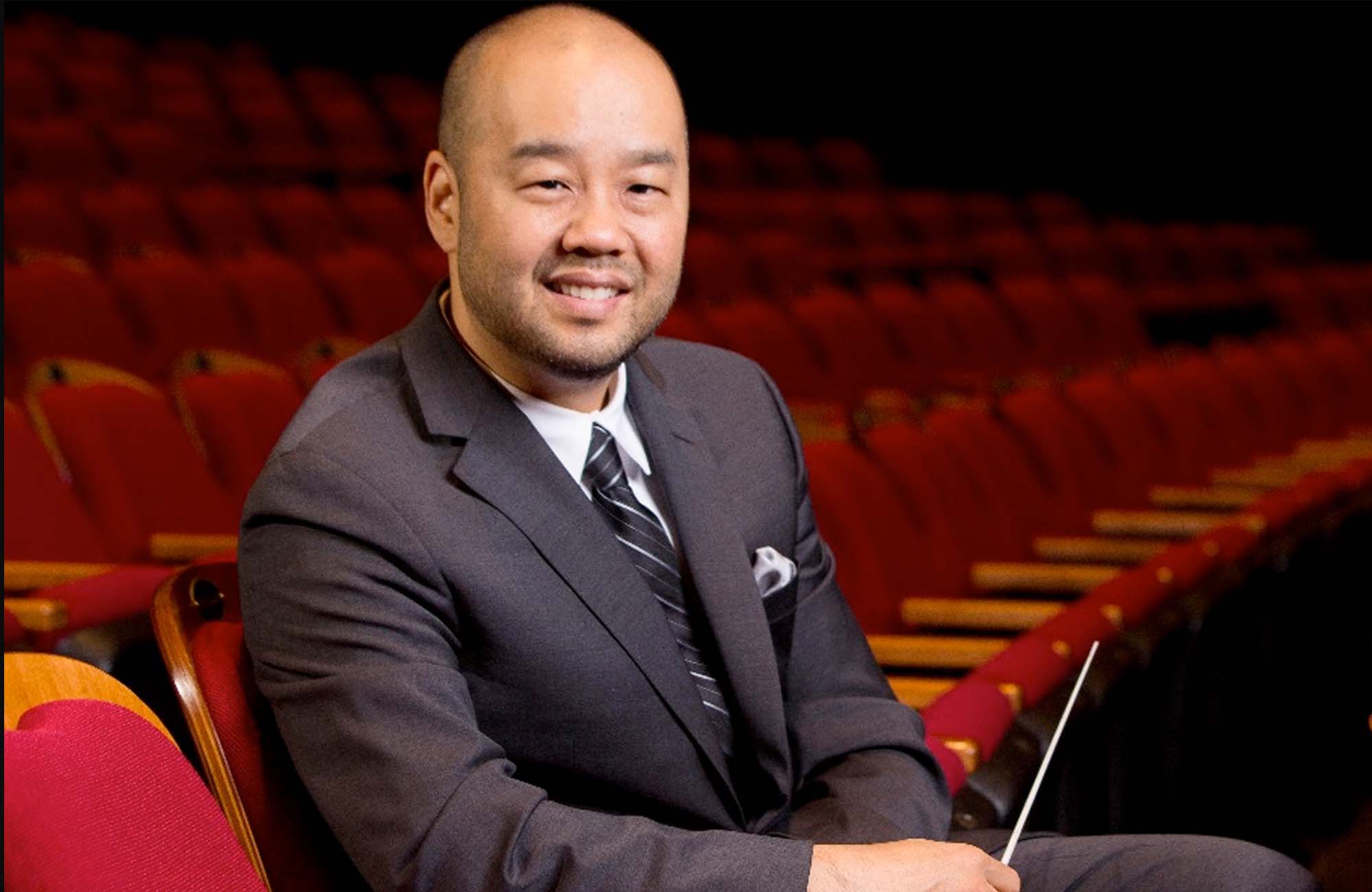
Described as bringing an “artisan storyteller’s sensitivity… shaping passages with clarity and power via beautifully sculpted dynamics… revealing orchestral character not seen or heard before” (Arts Knoxville) Lawrence Loh enjoys a dynamic career as a conductor of orchestras all over the world.
After an extensive two ...
Described as bringing an “artisan storyteller’s sensitivity… shaping passages with clarity and power via beautifully sculpted dynamics… revealing orchestral character not seen or heard before” (Arts Knoxville) Lawrence Loh enjoys a dynamic career as a conductor of orchestras all over the world.
After an extensive two year search, Lawrence Loh was recently named Music Director of the Waco Symphony Orchestra beginning in the Spring of 2024. Since 2015, he has served as Music Director of The Syracuse Orchestra (formerly called Symphoria), the successor to the Syracuse Symphony Orchestra. “The connection between the organization and its audience is one of the qualities that’s come to define Syracuse’s symphony as it wraps up its 10th season, a milestone that might have seemed impossible at the beginning,” (Syracuse.com) The Syracuse Orchestra and Lawrence Loh show that it is possible to create a “new, more sustainable artistic institution from the ground up.”
Appointed Assistant Conductor of the Pittsburgh Symphony in 2005, Mr Loh was quickly promoted to Associate and Resident Conductor within the first three years of working with the PSO. Always a favorite among Pittsburgh audiences, Loh returns frequently to his adopted city to conduct the PSO in a variety of concerts. Mr. Loh previously served as Music Director of the West Virginia Symphony Orchestra, Music Director of the Northeastern Pennsylvania Philharmonic, Artistic Director and Principal Conductor of the Syracuse Opera, Music Director of the Pittsburgh Youth Symphony Orchestra, Associate Conductor of the Dallas Symphony Orchestra, Associate Conductor of the Colorado Symphony Orchestra and Music Director of the Denver Young Artists Orchestra.
Mr. Loh’s recent guest conducting engagements include the San Francisco Symphony, Dallas Symphony, North Carolina Symphony, Baltimore Symphony, Sarasota Orchestra, Florida Orchestra, Pensacola Symphony, Atlanta Symphony, National Symphony, Detroit Symphony, San Diego Symphony, Seattle Symphony, National Symphony (D.C.), Utah Symphony, Rochester Philharmonic, Indianapolis Symphony, Calgary Philharmonic, Buffalo Philharmonic, Albany Symphony and the Cathedral Choral Society at the Washington National Cathedral. His summer appearances include the festivals of Grant Park, Boston University Tanglewood Institute, Tanglewood with the Boston Pops, Chautauqua, Sun Valley, Shippensburg, Bravo Vail Valley, the Kinhaven Music School and the Performing Arts Institute (PA).
As a self-described “Star Wars geek” and film music enthusiast, Loh has conducted numerous sold-out John Williams and film music tribute concerts. Part of his appeal is his ability to serve as both host and conductor. “It is his enthusiasm for Williams’ music and the films for which it was written that is Loh’s great strength in this program. A fan’s enthusiasm drives his performances in broad strokes and details and fills his speaking to the audience with irresistible appeal. He used no cue cards. One felt he could speak at filibuster length on Williams’ music.” (Pittsburgh Tribune)
Mr Loh has assisted John Williams on multiple occasions and has worked with a wide range of pops artists from Chris Botti and Ann Hampton Callaway to Jason Alexander and Idina Menzel. As one of the most requested conductors for conducting Films in Concert, Loh has led Black Panther, Star Wars (Episodes 4-6), Jaws, Nightmare Before Christmas, Jurassic Park, Casablanca, The Wizard of Oz and Singin’ in the Rain, among other film productions.
Lawrence Loh received his Artist Diploma in Orchestral Conducting from Yale, his Masters in Choral Conducting from Indiana University and his Bachelor of Arts from the University of Rochester. Lawrence Loh was born in southern California of Korean parentage and raised in Carlisle, Pennsylvania. He and his wife Jennifer have a son, Charlie, and a daughter, Hilary. Follow him on instagram @conductorlarryloh or Facebook at @lawrencelohconductor or visit his website, www.lawrenceloh.com


